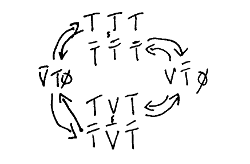Next: The puzzle of the Up: Decay Patterns as Phase Previous: Kaon phase transitions Contents
It is a relief to see that the rules observed so far can cope even with Kaons. There was some concern for a moment!
So far, it is interesting to note that except for neutron-proton phase shifts, no "virtual" particles involving TTT or VVV have ever been needed (and even then that may be more of a mathematical summary - literally a sum - than a true indication of what is really happening). By "virtual" particles this is the process by which a pair of Rishons are brought into existence for long enough such that they may be both the input and output of a pair of VT0 phase shifts. This makes sense in that the creation of "Virtual Pions" (most virtual particles appear to be Pion+, Pion-0 of either the up or down variety, or Pion-) comprise +2/3 and -1/3 charges which could then phase-transition either way. Referring back to Figure 5 and looking at the VT0 phase transformation options, particles with TTT or VVV may only phase shift one and only one way, whereas particles with VTV or TVT have two possible decay paths.
So consider if it were possible for a TTT and
![]()
![]()
![]() to spontaneously
spring into existence (even for an immeasurably brief time-period).
What pair of phase transformations could occur which have as both the
input and the output those exact same particles on both sides of the
equations? The only options available result immediately in the annihilation
of the particle-anti-particle pair, with, ironically, an up quark and anti-up
quark (i.e. a Pion-0) as the additional virtual intermediary to facilitate
that annihilation! Not only that but the annihilation is forced to use
the exact same pairs of particles. By contrast, due to the fact that
2/3 - 1/3 = 1/3 - 2/3, in the case where virtual Pions are used, it is
possible for each of the matched VT0 phase transformations, in the
"creation" part of the virtual Pions, to use one of each of the two
quarks, and in the "destruction" part to use the exact opposite pair.
to spontaneously
spring into existence (even for an immeasurably brief time-period).
What pair of phase transformations could occur which have as both the
input and the output those exact same particles on both sides of the
equations? The only options available result immediately in the annihilation
of the particle-anti-particle pair, with, ironically, an up quark and anti-up
quark (i.e. a Pion-0) as the additional virtual intermediary to facilitate
that annihilation! Not only that but the annihilation is forced to use
the exact same pairs of particles. By contrast, due to the fact that
2/3 - 1/3 = 1/3 - 2/3, in the case where virtual Pions are used, it is
possible for each of the matched VT0 phase transformations, in the
"creation" part of the virtual Pions, to use one of each of the two
quarks, and in the "destruction" part to use the exact opposite pair.
 figureshowing how electron-positron phase shifts don't go anywhere
figureshowing how electron-positron phase shifts don't go anywhere
|
So with the exception of position-altering phase transformations (changing the order of Rishon triplets in I-Frames), electron-positron and neutrino anti-neutrino "virtual particles" are not involved in phase transitions - at least not any that result in the creation of new particles (aka particle "decay").
Put in Standard Model language: Pions are the predominant "gluons", and only Pions can result in particle creation (note: in fact, a Pion+ and a Pion- are the constituent parts of a VT* event). Interestingly, assuming an initial zero energy state, the startling implication of this is that the "Big Bang" would, at its very conception, have started out exclusively from Pions.
There is one other observation which is noteworthy: at no time has a phase transition involving I-Frame particles left any one of the three triplets alone, nor in the case of dual particles (pions, kaons). In other words, all the Rishon triplets of an I-Frame (or both Rishons of a dual-Rishon particle) seem to need to undergo a phase transition: simultaneously, at that. It would also appear that (as with the Pion transitioning to a Muon-neutrino and Muon) the creation of I-Frame particles also needs to occur simultaneously. In other words, an I-Frame particle (such as a proton, Muon or any of the heavier quarks) cannot simply pick up a random Rishon triplet and combine with it: the creation of the heavier particle must occur as a result of two or three simultaneous VT0 phase transformations, by a process of "permitting" the three triplets to "jump into" a stable arrangement, even if (as seen in the neutron-proton case) one of those phase transformations merely switches the order of the triplets.
The probable reason for this is that the binding energy which held the twin or triplet together would be massively disrupted. A pair of matched phase transitions however would be minimally disruptive to both the momentum and energy state of these compound particles. In the case of I-Frame particles, this does raise the question however: expressed in Rishon terms, what kind of process and energy (apart from a Pion+ to Muon decay) does it take to create heavy I-Frame triplets, especially Neutrons and Protons? Is there some clue here as to how Fusion takes place? Would it be easier, in Rishon terms, to help experimentally explain the circumstances behind the phenomenon named by the term "cold fusion", perhaps?
lkcl 2016-12-29